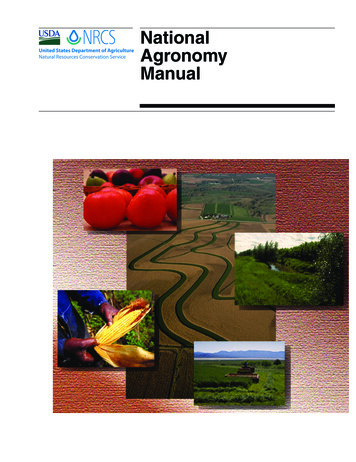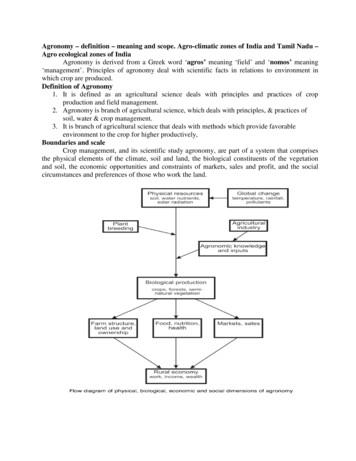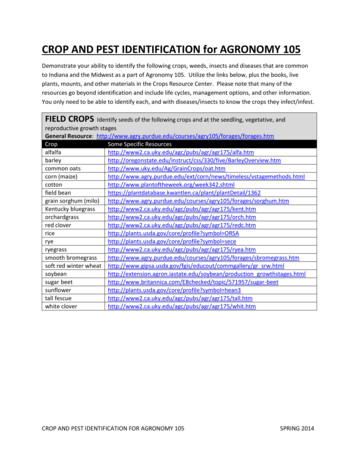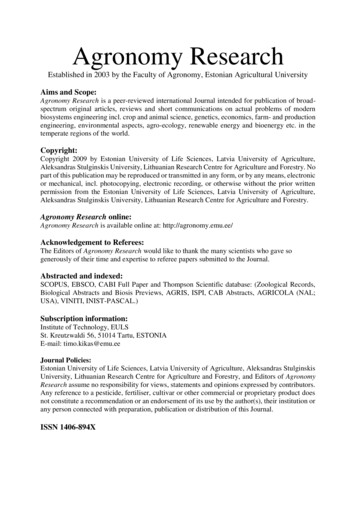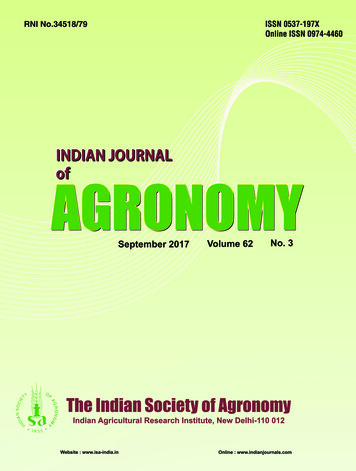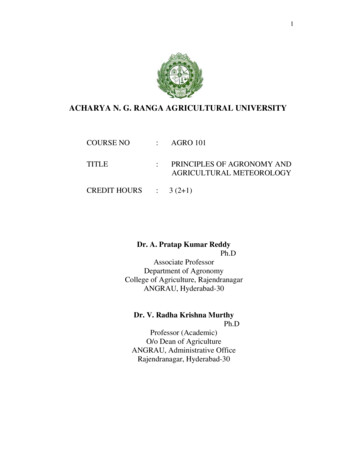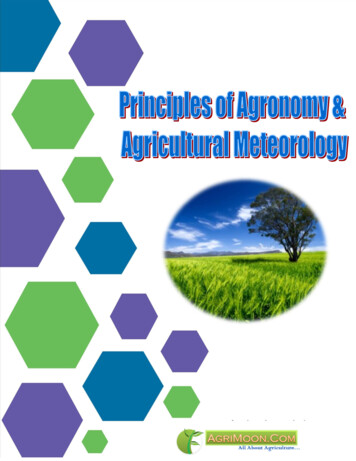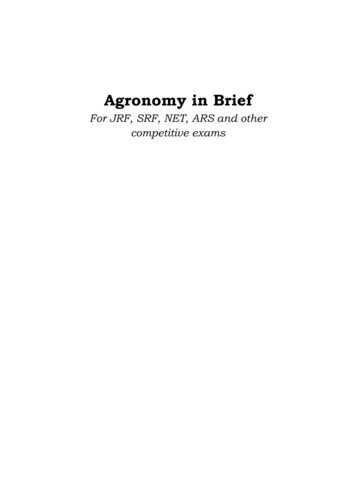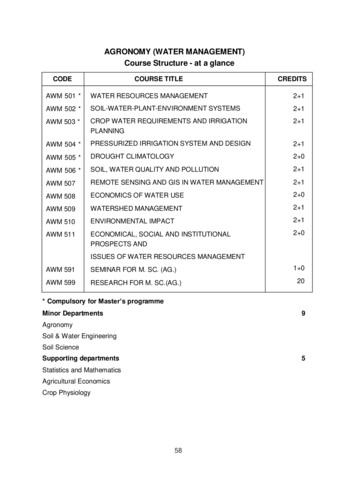
Transcription
AGRONOMY (WATER MANAGEMENT)Course Structure - at a glanceCODECOURSE TITLECREDITSAWM 501 *WATER RESOURCES MANAGEMENT2 1AWM 502 *SOIL-WATER-PLANT-ENVIRONMENT SYSTEMS2 1AWM 503 *CROP WATER REQUIREMENTS AND IRRIGATIONPLANNING2 1AWM 504 *PRESSURIZED IRRIGATION SYSTEM AND DESIGN2 1AWM 505 *DROUGHT CLIMATOLOGY2 0AWM 506 *SOIL, WATER QUALITY AND POLLUTION2 1AWM 507REMOTE SENSING AND GIS IN WATER MANAGEMENT2 1AWM 508ECONOMICS OF WATER USE2 0AWM 509WATERSHED MANAGEMENT2 1AWM 510ENVIRONMENTAL IMPACT2 1AWM 511ECONOMICAL, SOCIAL AND INSTITUTIONALPROSPECTS AND2 0ISSUES OF WATER RESOURCES MANAGEMENTAWM 591SEMINAR FOR M. SC. (AG.)AWM 599RESEARCH FOR M. SC.(AG.)1 020* Compulsory for Master’s programmeMinor Departments9AgronomySoil & Water EngineeringSoil ScienceSupporting departments5Statistics and MathematicsAgricultural EconomicsCrop Physiology58
Non credit compulsory coursesCODECOURSE TITLECREDITSPGS 501LIBRARY AND INFORMATION SERVICES0 1PGS 502TECHNICAL WRITING AND COMMUNICATION SKILLS0 1PGS 503(e-course)INTELLECTUAL PROPERTY AND ITSMANAGEMENT IN AGRICULTURE1 0PGS 504BASIC CONCEPTS IN LABORATORY TECHNIQUES0 1PGS 505(e-course)AGRICULTURAL RESEARCH, RESEARCHETHICS AND RURAL DEVELOPMENT PROGRAMMES1 0PGS 506(e-course)DISASTER MANAGEMENT1 059
AWM 501WATER RESOURCES MANAGEMENT2 1ObjectiveTo impart knowledge on water status, resources, runoff, ground water assessment for managingthe water sources with simulation modeling, optimal allocation and conjunctive use.TheoryUNIT IHydrologic cycle and Hydrologic Processes.UNIT IIIndia’s water resources and their development.UNIT IIIWater needs for future in different sectors. Water resources data.UNIT IVAnalysis of rainfall data, soil water balance, runoff estimation.UNIT VGround water concept, porosity, permeability and transmissivity. Basic equations of groundwater flow. Identification of recharge zones and boundaries. Assessment of recharge andaquifer system.UNIT VIIrrigation water distribution practices in IndiaUNIT VIIPrinciples of decision making in water resources, planning and management –systemsanalysis, identification of objectives, benefits, costs, decision variables, constraints andproduction functions, use of simulation optimization models and forecasting models.UNIT VIIIExpert systems, decision support systems for planning and operation, water managementprojects. Conjuctive use of canal and ground water in irrigation projects. Water qualitymanagement models, case studies.PracticalAnalysis of rainfall data, Application of soil water balance by estimating all components ofwater balance, Estimation of runoff, Estimation of infiltration, Estimation of permeability,Formulation and application of Ground water flow model, Assessment of ground water potential,Use of simulation model for water resources planning, Use of optimization model for optimalwater allocation, Use of DSS for water resources management, Use of water quality model,Use of DSS for water resources management and water qualitySuggested ReadingsArora, K.R.1996. Irrigation, Water power and water resources Engineering. Standard Publishersdistributors, 1705-B, Nai Sarak, Post Box No. 1066, New Delhi-6Ritzema, H.P. (Editor-in-chief).1994. Drainage Principles and Applications –ILRI Publications16, International Institute for Land Reclamation and Improvement. P.O.Box 45, 670UAA Wageningen, The Netherlands.60
Todd D.K.John . 1959. Ground Water hydrology. Wiley and sons, New York.De Vries J.J and Hromadka. T.V. 1992. Computer models for surface water – MC Grow Hill,New YorkMaidment D.R. (Ed)1992. Hand book of Hydrology. MC Grow Hill New YorkAndrew Albert Dzurik Rowman and Littlefield .1992. Water Resources Planning. MC Grow HillNew YorkAWM 502SOIL WATER PLANT ENVIRONMENT SYSTEMS2 1ObjectiveTo have comprehensive understanding of soil-plant-water regimes in relation to climate forplanning an efficient irrigation system.Unit- I: Soil Water RelationsSoil profile and horizon description. Soil physical properties-Texture, structure, bulk density,particle density, pore space, soil depth, soil /plough pan, Adhesion ,Cohesion, capillarityetc,. Water structure, physical properties of water. Energy concept of soil water-redoxpotential, solute content and its movement in soil. Soil moisture constants. Theories ofwater availability. Soil hydraulic properties. Soil moisture measurement.Unit –II: Plant Water relationsRole of water in plant,. Water relationship of cell and whole plant-water and ion uptake andmovement mechanism in plant systems. Concept of plat water potential and theirmeasurement. Factors affecting plant water absorption. Plant structure and rootdevelopment-effective root zone depth-moisture sensitive stages. Water stress and plantgrowth.Unit – III: EvapotranspirationEvapotranspiration (ET)-evaporation, transpiration, factors influencing ET. Measurementof actual ET. Measurement of PET-empirical methods. Weather parameters-solar radiation,air temp., air humidity, wind speed and their measurement. Soil-Water –Plant-AtmosphereContinum (SPAC).Energy balance at crop surface. Control of ET losses. Aridity indices.Crop Co-efficient (Kc). Yield response factor(Ky).PracticalStudy of soil profile and description of soil profile horizons, Estimation of bulky density, Estimationof particle density, Determination of Field capacity by field method, Determination of permanentwilting point by field method, Determination of infiltration rate, Determination of hydraulicconductivity under saturated conditions, Determination of moisture retention characteristics ofsoil in laboratory by pressure plate apparatus, Determination of soil moisture content byTensiometer, Measurement of soil moisture content by TDR/Profile probe, Measurement ofplant water potential, Working of crop ET problems, Measurement of weather parameters,Study of aridity indices- case studies, Study of influence of water stress on crop yieldSuggested ReadingsPanda, S.C. 1996. Agronomy. Agro-Bios(India), Jodhpur61
Reddy, S.R. 2007. Irrigation Agronomy. Kalyani publishers, New DelhiMichael, A.M. 1992. Irrigation-Theory and Practice. Vikas publishers, New DelhiMisra, R.D. and M.Ahmed. Manual on Irrigation Agronomy. Oxford and IBH publishers FAO.Irrigation and drainage paper No. 56Shankara Reddi, G.H.and T.Yellamanda Reddy 2002 Efficient use of irrigation water. Kalyanipublishers, New DelhiMukund Joshi and T.K.Prabhakar Setty. 2006. Irrigation and water management Kalyanipublishers, New Delhi.Majumdar, D.K. 2002. Irrigation Water management-Principles and practice. PHI Pvt.Ltd, NewDelhi.AWM 503CROP WATER REQUIREMENTS AND IRRIGATION PLANNING2 IObjectiveTo impart knowledge to students on hydraulics, design of channels, crop water requirementand irrigation planningUnit IProperties of fluids, fundamentals of fluid flow, steady flow, uniform flow, equation ofcontinuity, energy equation and momentum equation. Open channel flow, Manning’sequation, Chezy’s equation, hydraulic jump, normal depth, laminar flow, Reynold’s number,turbulent flow, Darcy’s Weisbach equation, friction factor.Unit IIDesign of channels, flow in closed conduits, Measurement of irrigation water and empiricalequations for water flow, weirs, notches, orifices and empirical equations.Unit IIILand use capability and soil and land irritability assessment. Factors affecting irrigationwater requirement, estimation of seasonal and annual water, land irrigation requirement ofcrop (s). Estimation of progressive, seasonal and peak consumptive water use and itssignificance in operation of an irrigation project.Unit IVIrrigation scheduling to crops, and different irrigation methods. Crop response functions toirrigation. Matching of net irrigation demand to water supply characteristics throughmodification of irrigation technology. Cropping pattern and cropping intensity, crop planningin relation to changing scenario of water availability.PracticalAssessment of types of flow, Design of open channels, Field visit to canal command area,Design of channels based on command area and cropping pattern, Measurement of irrigationwater using weirs, Measurement of irrigation water using flumes and current meter, Design ofsurface irrigation methods, Design of surface irrigation methods – Surdev model, Design ofsurface irrigation methods - exercises, Calculation of crop water requirement – Kc curve andreference crop ET, Calculation of crop water requirement – Average, peak and seasonal wateruse, Calculation of Irrigation requirement of important crops and water use efficiency,Estimation of irrigation efficiencies, Study of crop response functions to irrigation, Irrigationscheduling to important crops, Irrigation scheduling to important crops62
Suggested ReadingsMurthy, V.V.N. 1985. Land and water management engineering. Kalyani Publications, NewDelhi.Ven T Chow. 1976. Open channel hydraulics. New York, McGrow-HillDilip Kumar Majumdar, 2002. Irrigation and water management Principles and Practices.Prentice – Hall of India Private Limited, New Delhi.Lenka, 2005. Irrigation and Drainage. Kalyani Publishers, Hyderabad.Sankara Reddi, G.H. and Yellamanda Reddy, T. 2002. Efficient use of irrigation water. KalyaniPublishers, New Delhi.Michael. A.M. 1992. Irrigation Theory and practice. Vikas Publishing house Private Limited,New Delhi.Sehgal, J. 1996. Pedology – concepts and applications. Kalyani Publications, New Delhi.AWM 504PRESSURIZED IRRIGATION SYSTEM AND DESIGN2 1ObjectiveTo impart knowledge on importance of Sprinkler and Drip irrigation systems, designconsideration of system components for efficient and economical adoption of the system.TheoryUNIT IAn overview of Sprinkler irrigation, types of systems, components of system, designobjectives, uniformity, adequacy and efficiency of application.UNIT IIDesign of different types of sprinklers, Design of pipe lines, laterals manifold, submain andmains, Design of traveler sprinkler system, layout, nose selection, gun sprinklers.UNIT IIITrickle irrigation overview, types of system, and components of the system.UNIT IVDesign objectives of Trickle irrigation system, uniformity, adeqnacy and efficiency ofapplication.UNIT VDesign of Trickle system, layout, emitter selection, lateral design, control head components,filtration and fertigation.PracticalStudy of components of sprinkler irrigation system, Designing of Sprinkler irrigation systemfor groundnut, Irrigation scheduling procedure for sprinkler irrigation of field crops, CalculatingChristiansen’s coefficient of uniformity with experimental data, Visit to Sprinkler irrigated croppedfield, Study of components of drip irrigation system, Irrigation scheduling procedure for dripirrigation of fruit trees, Irrigation scheduling procedure for drip irrigation of row crops, Designingof drip irrigation system for sugarcane, Designing of drip irrigation system for vegetables,Designing of drip irrigation system for mango, Demonstration of fertigation practice, Evaluationof design emission uniformity, Acid treatment for drip irrigation system, Chlorination of dripirrigation system, Visit to drip irrigated mango & grape orchard63
Suggested Readings1. James, L.G. 1988. Principles of Farm Irrigation System Design. John Wiley & Sons Inc.,New York 101582. Burt, C.M. and Styles, S.W. 1999. Drip & Microirrigation for Trees, Vines and Row crops.ITRC, California Polytechnic State University, San Luis Obispo, California3. Burt, C.M., O’Connor, K. and Ruehr, T. 1998. Fertigation. ITRC, California PolytechnicState University, San Luis Obispo, California 934074. Benami, A. and Ofen, A. 1993. Irrigation Engineering – Sprinkler, Trickle, Surfaceirrigation principles, Designs and Agricultural Practices. Michlol, Ltd., Haifa, Israel 320005. Bucks, D.A., Nakayama, F.S. and Warrick, A.W. 1983. Trickle irrigation for crop production.Elsevier Publications, Amsterdam, NetherlandsC.No. AWM 505DROUGHT CLIMATOLOGY2 0ObjectiveTo impart the knowledge to the students on climatology of drought, impact and assessment ofdrought, monitoring and combating of droughtUnit IDefinitions; Causes, climatology of drought, EL Nino and La Nina, Synoptic weather systemsduring drought, drought indices and characteristics.Unit IISignificant droughts in India. Impact of climate change on water resources. Agronomicpractices during drought. Forest fire and drought, drought impact and assessment,Unit IIICrop weather forecasting –modification of microclimate through heat evasion and trappingmodification of weather through solar radiation management. Case studies of successfulmicrometeorological applications.Unit IVDrought monitoring, Drought mitigation and advisory services, Drought prediction, appraisaland drought policy. Drought proofing and management .Unit VModern tools including remote sensing and GIS in monitoring and combating droughts.Suggested ReadingsRamakrishna,Y.S., Rao, G.G.S.N., Sastry, P.S.N. and Rao, V.U.M.(Editors). 2006. Agriculturaldrought: Aspects of Micro meteorology 4 th SERC School – DST Sponsored Programme(25 th Sep to 15th Oct, 2006). CRIDA, HyderabadGhadekar, S. R. MeteorologyPrasada Rao, G.S.L.H.V. Agricultural Meteorology.Anji Reddy, M, 2006. Text book of Remote sensing and geographical information system. B.S.Publications.64
Chakraborty Sahoo, R.N. 2004. Fundamentals of Geographic information system. Viva booksChang, J.M. 1968. Climate and Agriculture. Aldine publicationsLal, D.S.1998. Climatology. Sharda pustak bhawanThompson, R.1997. Applied climatology. Principles and practice. Rout ledgeRamsastry, A.A. 1984. Weather and weather forecasting. Publication division, GOI, New Delhi.Singh, S.V., Rathore, L.S and Trivedi, M.K.N. 1999. A guide for Agrometeorological Advisoryservices. Department of science & Technology, NCMRWF, New DelhiAWM 506SOIL AND WATER QUALITY AND POLLUTION2 1ObjectiveTo impart knowledge about different indicators of soil and water quality, their impact on soilproductivity and their assessment and management. The course also provides insight in to thecauses, effects and control of soil and water pollution.TheoryUNIT ISoil Quality- Quantitative indicators of soil quality (physical, chemical andmicrobiological)- minimum data set – Physical: texture, soil depth, infiltration, bulkdensity, water holding capacity, aggregate stability- Chemical: organic carbon, pH, EC,extractable NPK, Sodium Absorption Ratio - Microbiological: microbial biomass C and N,soil respiration, potentially mineralizable N (anaerobic incubation)- integration of indicatorsinto soil quality index using Soil Management Assessment Framework (SMAF), a tool forquantitative soil quality evaluation method developed by USDA.UNIT IIWater quality- guidelines and criteria for soil quality evaluation – water quality relatedproblems in irrigated agriculture (salinity, low infiltration, specific ion toxicity andmiscellaneous problems) – Salinity: build up of salinity, effect on crops, management,drainage and control by leaching, crop tolerance and cultural methods. Infiltration problems:evaluation, management, soil, water amendments, deep tillage, organic residues, irrigationmanagement – Specific ion toxicity: Effect of Cl, Na, B, management-leaching, cropselection, cultural practices, toxicity effects due to sprinkler irrigation – Miscellaneousproblems: excess nitrogen, abnormal pH, scale deposits, clogging in drip irrigation system,metal corrosion. Water quality for live stock -Waste water reuse – case studies.UNIT IIISoil Pollution – Land application of wastes: bio-solid wastes, industrial effluents, distilleryand paper mill effluents, Tannery and textile industrial effluents – Mechanism of interactionof wastes with soil – effect of sewage waste application on soil characteristics and cropresponses, excessive use of fertilizers – excessive nitrates – heavy metals contaminantsin fertilizers as soil pollutants, pesticides, insecticides, fungicides, herbicides – reducingpesticide levels in soils – potentially toxic elements: Cd, Pb, Hg, Ni, Cr, Se, As – reducingheavy metal pollution in soil – radio nuclides – case studies.UNIT IVWater pollution: Indicators of water pollution - Categories of water pollutants: organic matter,pathogens, plant nutrients, sediments, petroleum oil, radioactive materials, heat – Sources65
of water pollutants: domestic waste water, infectious agents, plant nutrients, industrialwater pollution, Agricultural water pollution, solid waste pollution, thermal and radioactivepollution – Effect of water pollutants on aquatic biota – state of ground water pollution inIndian cities –case studies - purification of water: drinking and sewer water – Legislation –Environment Protection Act and Water (prevention and control of pollution) Act.UNIT IVManagement and improvement of soil and water quality - improving the crop productivity.PracticalCollection of soil samples from different ecosystems (Forestry, Agro Forestry, Cultivated fields,Grass lands etc). Entry operations and sample preparation, Visit to pollution affected areas inthe city and collection of soil and water samples. Entry operations and sample preparation,Introduction to Soil Management Assessment Framework (SMAF) – a tool for evaluation of soilquality – minimum data set for quantification of soil quality indicators, Estimation of physicalsoil quality indicators: bulk density, texture, Estimation of Aggregate stability, Soil moistureretention at field capacity and wilting point using pressure membrane apparatus, Infiltrationstudies in soils under different ecosystems, Microbial biomass carbon and nitrogen estimation,Respiration studies in soils under different ecosystems, Estimation of chemical soil andwater quality indicators: Estimation of pH, EC in soil and water samples and organic carbonin soil samples, Estimation of Na, Ca and Mg of soil and water samples and computation ofSAR, Estimation of extractable N of soils, Estimation of extractable P and K of soils,Estimation of carbonates, bicarbonates, chlorides (Residual Sodium Carbonate), nitrates andboron in waterSuggested ReadingsAyers, R.S. and Westcot, D.W. 1994. Water quality for Agriculture, FAO Irrigation and DrainagePaper 29. Rev. 1.Chandra Sekhar, M. and Sankara Rao, M. 2004. Environmental Science. 5th Edn. The HiTechPublishers, Hyderabad.ISSS. 2002. Fundamentals of Soil Science. Indian Society of Soil Science. IARI. New Delhi.John W Doran and Alice J Jones. 1996. Methods of Assessing Soil Quality. Soil ScienceSociety of America Special Publication No. 49, Inc. Madison, Wisconsin, USA.Ramesh Chandra and Satish Kumar Singh. 2009. Fundamental and Management of Soil Quality.Westville Publishing House, New Delhi.Susan S Andrew, Douglas L. Karlen and Cynthia A. Cambardella. 2004. The Soil ManagementAssessment Frame work. A Quantitative Soil Quality Evaluation method. Soil ScienceSociety of America Jouranl. Vol. 68, Nov-Dec. pp 1945-1762.Srivastava, K.P. 2001. An introduction to environmental study. Kalyani Publishers, Hyderabad.Tandon, H.L.S. 1993. Methods of analysis of soils, plants, waters and fertilizers. FertilizerDevelopment and Consultation Organisation. New Delhi.U.G.C. 2005. Text Book of Environmental studies for undergraduate courses. University GrantsCommssion. Universities Press (India) Private Ltd.USDA. 1998. Soil Quality Test Kit Guide. United States Department of Agriculture, AgriculturalResearch Service, Natural Resources Conservation Service. Soil Quality Institute66
AWM 507REMOTE SENSING AND GIS IN WATER MANAGEMENT2 1ObjectiveThe course provides an insight into the principles and basic concepts of Remote Sensing,Geographical Information System, techniques of satellite data processing and application ofthese modern tools for inventory, monitoring and management of different aspects of watermanagement in Agriculture.TheoryUNIT IElements involved in remote sensing, Electromagnetic spectrum, Remote Sensingterminology, Energy Sources, Energy interactions with earth surface features andatmosphere, spectral properties of vegetation, soil and water bodies. Resolution, Sensorsand Satellites, Visual Interpretation techniques- Basic elements.UNIT IIGIS definition and Terminology, GIS categories, Components of GIS, fundamentalOperations of GIS, A theoretical Frameworks for GIS, GIS types of data representation,Raster and Vector Data Structures, Comparisons between data Structures.Map language– spatial elements, classification of maps, map scale, map projections. Map referencingsystem – national and international Satellite data.UNIT IIIDigital Image Processing techniques - Image rectification and registration-Imageenhancement-Image classification-Accuracy assessment, Data merging and Dataintegration.UNIT IVCrop inventory – Acreage estimation, Production forecasting and Condition assessment.Land Use/Land cover analysis. Irrigated Land assessment and inventory – Assessment ofIrrigation water requirements – Irrigation Scheduling – Assessment of surface water logging.evapotranspiration estimation, Remote sensing based approaches for soil moistureassessment.UNIT VFlood plain zoning, Drought assessment and monitoring, Hydrological characterization ofwatershed, Soil erosion modeling and erosion hazard assessment.PracticalAcquaintance with instruments used in Remote Sensing, Introduction of RS and GIS software’s–Topographic sheets-Map language-Reference system, Study of boarder information of satelliteimages - Using image processing software (Erda imagine) - Loading of Satellite data and Preprocessing geo rectification and registration of toposheets and satellite image and mosaicing,Image enhancement techniques band rationing – image merging, Use of Spectro radiometer –Spectral reflectance of crops and soils, Calculation of spectral indices, Handling of Globalposition system, Unsupervised classification for land use land cover mapping, Supervisedclassification techniques, Map preparation – legend – graticules, index, Visit to NRSA, InfraredThermometer and its use in scheduling irrigation – calculation of various thermal indices likeCWRI (Crop Water Stress Index, Visit to AP State Remote Sensing Application Centre (APSRAC)and A P Forestry Academy, Hyderabad, Watershed characterization and runoff assessmentusing Arc GIS67
Suggested ReadingsAnji Reddy, M. 2001. Remote Sensing and Geographical Information Systems. Second Edition.Book Syndicate Publication, Hyderabad.David L Verbyla. 1995. Satellite Remote Sensing of Natural Resources. Lewis Publishers,New York, Imprint of CRC Press, LLC, Florida, US.John R Jensen, 1986. Introductory Image Processing A remote sensing perspective SecondEdition. Printice Hall Series in Geographic Information Science, New Jersey.Indian Institute of Remote Sensing (IIRS), Dehradun. Lecture notes of PG Diploma in RemoteSensing applications in agricultureThomas M Lilles and Ralph W Kiefer. 2001. Remote Sensing and Image Interpretation. FourthEdition, John Wiley & Sons, Inc.New York. / Book Syndicate Publication, Hyderabad(Indian Edition)Venkataratnam, L. Ravi Sankar, T. and Sudarshana, R. 2004. Remote Sensing applications,Soils and Crops, status, issues and prospects. National Remote Sensing Agency,Hyderabad.AWM 508ECONOMICS OF WATER USE2 0ObjectiveTo impart the knowledge on production functions, optimum allocation of water and economicsof water.Unit ICrop response to irrigation water and application of production function for optimumutilization of irrigation water.Unit IIMathematical models of computer simulation/system analysis to water allocation andmanagement problems.Unit IIILinear programming, dynamic programming, multi-purpose and multi-objective waterresources development, allocation and optimization of irrigation water for increasing returns.Unit IVGroundwater economics and conjunctive use plan of water resources.Unit VWater trade and water pricing.Suggested ReadingsAlpha C. Chiang. 1984. Fundamental methods of mathematical economics. Mc Graco- Hillbook company, New Delhi.Palanisami, K. Paramasicam, P. and Ranganathan, R. 2002. Agricultural Production economicsAnalytical methods and applications. Associate publishing company, New Delhi.Heady O Earl and Dillon L. John. 1988. Agricultural Production Functions. Kalyani Publishers,New Delhi.68
Shenoy, G.1989. Linear programming – Principles and applications. Wiley Eastern publications.Dorfman, R. 1996. Linear programming and economic analysis. Mc Graw Hill.Lomba, N.P. 2006. Linear programming. Tata Mc Graw Hill.Vasertein, 2006. Introduction to linear programming. Pearson Education publicationAWM 509WATERSHED MANAGEMENT2 1ObjectiveTo impart the knowledge to students on concepts of watershed and integrated watershedmanagement with community participationUnit IConcepts of watershed components, delineation, problem identification, deterioration andpriority concepts. Land and water degradation. Land capability and land suitabilityclassification. Hydrological processes.Unit IIIntegrated watershed management, data base generation and management, impactevaluation and assessment. Watershed resources appraisal. Community participation,role of NGO’s and political will & support. Watershed management programmes in thecountry-overview, sustainability aspects, economic evaluation and environmentalassessment.Unit IIIConcepts of soil and water conservation, Soil and water conservation measures, Soilerosion. Effective life of dams and water retention structures. Mechanics of wind erosion;types of wind erosion and soil movement; wind erosion control measures.Unit IVAnalysis of hydrologic data including rainfall, evapotransipration; watershed characteristics;overland flow. Methods of estimation of runoff; peak rate and time distribution of hydrograph;synthetic hydrograph; infiltration process; hydrologic evaluation of land treatment. Erosioncontrol.Unit VThe role of soil water conservation work, river valley projects; soil conservation department,CADA etc.Suggested ReadingsKhan, M.A. 2006. Watershed Management for Sustainable Agriculture Agrobios, JodhpurOswal, M.C. 1999. Watershed Management (for dryland Agriculture, Associated PublishingCompany, New Delhi.Gunny Honore (Editor). 2002. Principles and practices of integrated watershed managementin India. Indo-German Bilateral Project on watershed development, New Delhi.Murthy, J.V.S. 1994. Watershed management in India, Wiley eastern limited, New Ageinternational limited, HyderabadDruvanarayana, V.V., Sastry, G. and Patnaik, U.S. 1990. Watershed management. ICAR,New Delhi.Tideman, E.M. 1996. Watershed Management – Guidelines for Indian conditions. Omegascientific Publishers New Delhi69
AWM 510ENVIRONMENTAL IMPACT2 1ObjectiveTo impart the knowledge to students on environmental impact of irrigation project and itsassessmentUnit INature of environmental impacts of water resources development, environmental impactstatement for irrigation and drainage projects, protocols, procedures and regulations inIndia, use of Geographic Information Systems for assessment and prediction of impacts.Unit IIPreparation of EIA reports on water resources projects, Social assessment, Risk anduncertainty and matrix methods in EIA. Agricultural non-point pollution sources. Modellingpollutant transport in runoff and sediment; modeling pollutant loadings to ground water.Case studies on EIA of irrigation and drainage projects.Unit IIIDefinition, Objectives, activities and basic aspects of diagnostic analysis of irrigation projects.Study and measurement of performance parameters. Interaction of productivity and wateruse efficiency under different fertility levels. Efficient utilization of irrigation water. Operationalmanagement of irrigation and drainage net works. Participatory irrigation water management.Unit IVFundamentals of conceptual framework for performance evaluation of irrigation projects.Evaluation of irrigation projects in relation to basic objectives. Equitable waterdistribution. Socioeconomic, political and organizational implications in the managementof irrigation systems.Unit VPricing of irrigation water. Case studies.Suggested ReadingsJoshi, L.K. and Rakesh Hooja (Editor). 2000. Participatory Irrigation Management –Paradigmfor the 21st Century. Pawat Publications, New Delhi.Bos, M.G., Burton, M.A. and Molden, D.J. 2005. Irrigation and Drainage performanceAssessment-Practical Guidelines. CABI publishing, UK and USA.Hosetti, B.B. 1998 Environmental impact assessment and Management. Daya Publishinghouse New Delhi.Trivedy, R.K. 2004. Hand book of Environment Laws, Acts, Guidelines, Compliances andstandards. B.S. Publications. HyderabadShansi, U.M. 2000. GIS applications for water, waste water and storm water systems, Taylor &Grancis, NewyorkPurohit, S.S. and Agrawal K.A. 2004. Environmental Pollution causes, effects and control.Agrobios (India), JodhpurRichard Helmer and Ivanildo Hespanbol (Editor) 1997 Water Pollution Control A guide to theuse of water quality management principles. E & FNSPON, An imprint of ThomasProfessional New york, MadrasKulkarni, V.S., Kaul, S.N. and Trivedy, R.K. 2002. A Hand book of Environment ImpactAssessment. Scientific Publishers (India), Jodhpur70
AWM 511ECONOMICAL, SOCIAL AND INSTITUTIONAL PROSPECTS ANDISSUES OF WATER RESOURCES MANAGEMENT2 0ObjectiveTo impart the knowledge to students on economical, social and institutional issues of waterresources managementUnit IPrinciples of economics and their application in water resources management. Economicdimensions of irrigation systems appraisal – economic appraisal of irrigation programmesand water harvesting technologies, project feasibility criteria, assessment of costs andbenefits and internal rate of return. Water resources pricing: theory and practice.Unit IIPolicy approaches for efficient on-farm water utilization – equity and efficiency in waterdistribution. Irrigation management alternatives and productivity impact.Unit IIIInstitutional framework in canal command and watershed areas. Organizations, their rolesand functions. Water users associations and par
Irrigation Agronomy. Kalyani publishers, New Delhi Michael, A.M. 1992. Irrigation-Theory and Practice. Vikas publishers, New Delhi Misra, R.D. and M.Ahmed. Manual on Irrigation Agronomy. Oxford and IBH publishers FAO. Irrigation and drainage paper No. 56 Shankara Reddi, G.H.and T.Yellama
